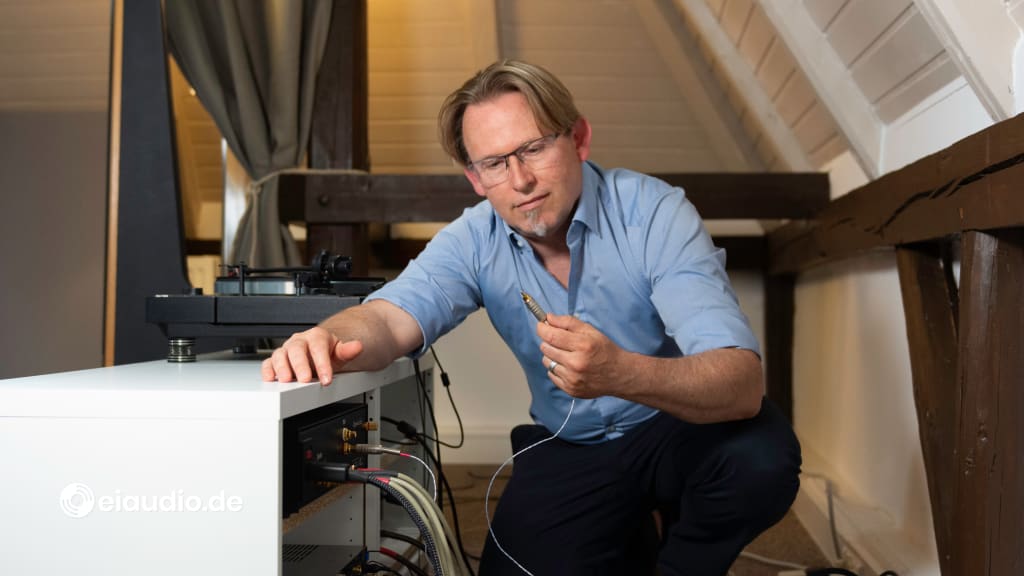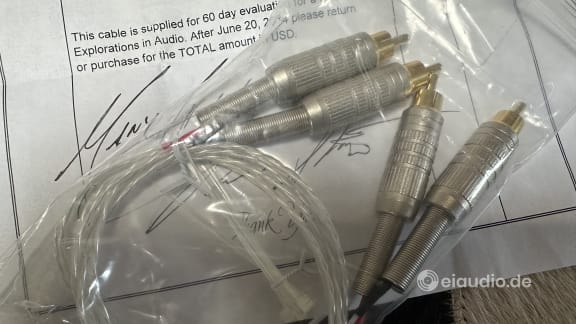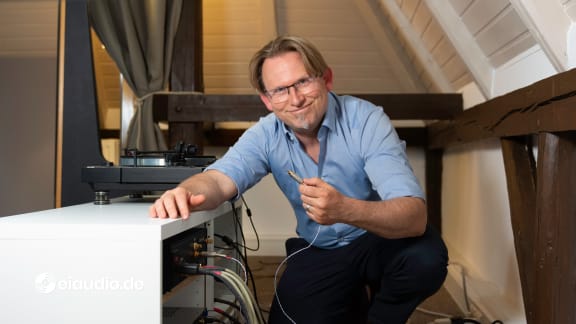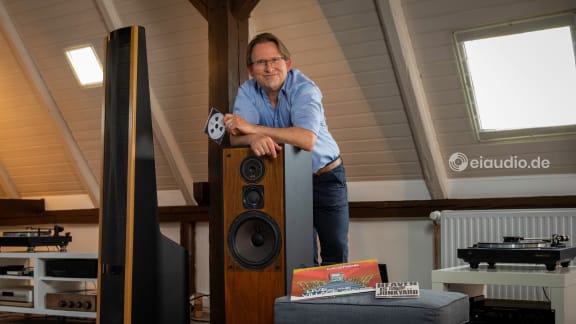Stager Silver Solids
Published: 27/05/2024
Manufacturing date: 1996
Author: Karsten Hein
Category: Gear & Review
Tag(s): Analog Interconnects
Marc Stager has a passion for audio. His business, Stager Sound Systems, is located in New York City, and provides high quality sound systems for concerts and special events. Marc’s focus on delivering undistorted and natural sound to both intimate and large-scale music venues also led him to explore the subject of wiring between the components and culminated in the development of his own line of audio cables. It was in this latter context that Marc reached out to me to inquire if I would be interested in writing a review on a set of his cables.
Marc’s query reached me at a time when we had just completed the move of our businesses and family from the bustling city of Frankfurt to the sleepy North Sea town of Marne. The new location provided eiaudio with its own 70 square meter listening space, along with an additional control room for recording purposes. And, for the first time in the history of this blog, I was able to set up systems completely outside the family’s living quarters, positioning my loudspeakers to fully factor in room resonances, treating the floors and walls for reduced reverb times, and assuring that clean electricity would reach each of my three HiFi systems (that I used for equipment testing) straight from the central fuse box of our stand-alone house. There was sufficient crawl space behind each rack to allow for carefully thought-out wiring schemes and to assure that there was no accidental cross-induction between the wires that would deteriorate soundstage or transients.
At that stage, I had already written over 180 articles and reviews on HiFi gear and recently established a connection with Symphonic Line, the German manufacturer of High End audio equipment. Testing their vintage components had rather unexpectedly broadened my horizon in terms of tonal accuracy in music reproduction. Although this was a subject that I had previously been aware of, I had never heard this aspect so flawlessly executed as to appreciate its value for the impression of musical integrity. To put it in a nutshell, I had established a professional testing environment and was now familiar with a whole new dimension of audio pleasures. Feeling set for my next stage of explorations, I eagerly wrote back to Marc saying that I would indeed be honoured to give his cables a listen and write a review on them.
The Stager Silver Solids arrived rolled up in an unpretentious cardboard envelope just a few days later. I inspected the cables and saw that they had survived the trip in excellent condition. My specimens were terminated with Marc’s standard Canare F10 Cinch/RCA connectors that have a machined brass centre, a Teflon insulator, and 24K gold-plated contacts. According to their specifications, the Canare plugs’ coil spring strain reliefs are able to take rather hefty wires of up to 6.0 mm in diameter, a fact that somehow made them look out of proportion when used in combination with the approximate 2 mm diameter of the two twisted Stager wire strands. The Canare F10 have a solid centre prong (rather than a hollow or split one) and use a non-adjustable ring ground rather than providing a single point of contact, which is the predominant fashion in High End applications these days.
Advert eiaudio/shop:
Stager’s cable conductor is manufactured from a twisted pair of 99.9% pure soft-temper 24 AWG solid-core silver wires. According to Marc, each strand is hand-polished to create a grainless surface and is then placed inside a translucent Teflon (PTFE) insulator. The cable ends are colour-coded red and black using Polyolefin heat shrink tubing. Without further mesh shielding in place, the cables are non-directional and can be connected either way. From their specifications, I gather that their ‘unshielded’ symmetrical design assures a low capacitance of 9 pF/ft. Protection from outside interference is provided by the cable’s twisted pair layout that is wound at approximately 1 cm per half-turn.
The idea of twisting cables for improved interference protection is not new. The first time I heard the term was in the context of telephone and LAN connections, where twisted pairs are found in combination with wire mesh and/or aluminum shielding to assure superior signal integrity. In cinch/RCA audio connections, twisted pair designs also have a long tradition. I once had a 22 AWG Western Electric cable for testing that used a twisted pair of solid-core copper with silk dialectic to generate exceptionally sweet-sounding vocals, above all else. My favourite all-round speaker cable (in conjunction with vintage loudspeakers) is the Belden 9497 that twists two wires of tinned copper multi-strands at a winding ratio of about 5mm length per half-turn. A comparable shielding effect is reached by means of tri-braided field geometry, as it is propagated by Kimber Kable, amongst others. I had the Kimber Timbre in my collection for a while and remember that this, too, served its purpose quite well.
Silver solid core wires are a completely different beast, of course. When it comes to audio connections, a solid core design offers great musical homogeneity, whereas silver provides superior connectivity. If the music signal ‘moves’ through copper, it ‘crashes’ through silver. When changing from copper to silver, I get the impression that the brakes come off, the music can finally breathe, dynamics can unfold, and that I am listening right through the recording to where the music hits the studio floor. I first discovered this phenomenon with the silver cables that Holger Becker made for me. I remember that we had lots of fun with our new discoveries and with each new cable became bolder, until shielding and plugs finally served to meet the benefits silver had to offer. Or so we thought.
Curious about how Marc Stager’s Silver Solids would perform in this context, I first connected his cables between my Cambridge DAC Magic and Symphonic Line RG2-MK3 preamplifier. I gave the setup about one week to break in and then first wrote my review on the RG2 preamp. The Silver Solids remained in the system for the duration of my review and positively contributed to some of my observations on the sound of the system. My own (first generation) silver solid core cable, running from the preamplifier to the Dynavox VR70E-II tube power amplifier, needed to be replaced, because Symphonic Line’s own Harmony HD cable managed to produce superior dynamics in this position, especially when playing in conjunction with Symphonic Line’s speaker cables. — Well, such is life.
When I finally focused on Marc’s cable for review, it had already played at least 80 hours of music. To fully mature, silver wires tend to take approximately 200 hours. It is therefore quite possible that some aspects remained hidden from me during my review. I started my session re-playing some local German music highlights, such as Bad As We, the Senior Jazz Trio, Anna Boulic, the Sunday Morning Orchestra, and Alexander Möckl from CD, all of which Heinz-Peter Völkel and Andreas Sandreuter had recorded in their Live||Tape sessions. Their idea was to record all the songs live using a professional reel-to-reel studio recorder, in order to show how well analogue recordings really worked. It was a fun project, and the only downside was that they had to transfer their masters to CD for me, because I did not have a tape machine of my own, yet. The recordings had an ‘anything-can-happen’ small stage flair to them, and I enjoyed listening to them a lot.
The Stager Silver Solids contributed to a tonally pleasant and engaging sound. They allowed low bass to thunder right through without any unnatural restraint. Somewhat unusual in the context of silver end-to-end cables was the fact that the treble remained soft and silky, instead of turning bright and crisp. I attributed this pleasant softening of the treble to the material transition from silver to gold-plated brass plugs. Despite this, there was sufficient detail retrieval to provide for a joyful presentation. I was happy to note that Symphonic Line’s trademark tonality remained intact. This made it possible to better distinguish between a multitude of singers and instruments when the session became crowded. After all, tonality also conveys feeling and thereby assures that we remain attentive to the music from an emotional perspective.
As with most twisted pair and braided cables, I found the stage to be huge and at times slightly out of proportion, with individual tonal events freeing themselves all to easily from the loudspeakers in an uncalled-for fashion. Under normal circumstances, I might not have noticed this ‘carelessness’ so much, if it had not been for Symphonic Line’s reputation for maintaining strict order and proportion in the music. To explore this effect further, I connected the Stager cable on my second system between the Symphonic Line RG9 integrated amplifier and RG11 power amp. In this scenario, the RG11 was driving the electrostatic panels of our Martin Logan SL3 loudspeakers, whereas the RG9 was supporting the bi-amping setup in driving the dynamic woofers. The Silver Solids did a tremendous job in terms of dynamics, tonal accuracy, and detail retrieval. However, the sensation of unbridled proportions remained.
Reading Adam LaBarge’s review of the Stager Silver Solids on 'The Audio Beatnik', I saw that Adam had also used them to positive effect between his turntable and preamplifier. As I had never been able to run twisted or braided cables in this rather delicate position myself, I decided to give this another chance and connected the Stager cables between my Dual CS-505-3 and RGR Model 4 preamplifier. Perhaps not surprisingly, the result was an obnoxious 50 Hz hum paired with some high frequency hissing. When I replaced the Silver Solids with Fast Audio’s Black Science or Symphonic Line’s “Das Schnelle”, any background noise disappeared at an instance. To assure that the Stager cables did not have a defect, I whipped out an older braided Audiocrast silver-clad copper interconnect and found that this produced even louder noise than Marc’s cable had done. Good to know that Marc also provides shielded phono cables that will perform much better in this position, nevertheless, our short phono experiment serves to demonstrate that differences in cable shielding do exist and matter.
Having arrived at my third HiFi system, I alternated between Audiocrast’s silver-clad OCC copper cable, Stager’s Silver Solids, and Symphonic Line’s “Das Schnelle”. The loudspeakers were my Epicure EPI 500, driven by a rare RG9-based power amplifier with RGR Model-4 preamp. The CD player was the rather enjoyable Pioneer PS-S604 with platter drive disc mechanism. I listened to the Jazz performances on Helge Lien’s double album “10” and to Youth Lagoon’s album “Heaven is a Junkyard”, and I enjoyed the Silver Solids a lot. They had an obvious tonal advantage over the silver-coated Audiocrasts and presented the music in a livelier fashion than even the Symphonic Line cables. When it came to maintaining order and proportion, however, the Symphonic Line’s better shielding proved to be superior.
The large soundstage effect, which has also been described by Adam LaBarge, could in part be caused by high frequency interference. Although the interference itself was inaudible in line applications, such as CD players with power levels of 2 Volts peak to peak (or 316 mV @-10dBV), it could become directly audible in more sensitive environments. Phono cartridges have a maximum output level ranging from 2 to 7 mV, depending on the cartridge type and model, and RIAA equalised amplification of phono signals is therefore much greater. And even if we cannot easily detect interference in line setups, its effects on music can be heard on the sensitive directional signals that are carried by high frequencies which can, as a result, seem out of place.
In their price range, Stager Silver Solids are a worthwhile investment. From many perspectives, they can keep up with audio cables many times their price. Because of their thin and rigid nature, they are not always easy to handle behind the rack. Their unshielded design makes them good companions for line operation. Listeners attracted to tonal correctness, dynamics, and detail retrieval will find pleasure with these cables. They are non-fatiguing due to a soft and silky top-end. However, listeners who are particularly fussy about accuracy in soundstage and dimension might be better served elsewhere. I have decided to keep my Stager cables close at hand, for example, to breathe new life into systems lacking in dynamics, detail, and tonality. They sure tickle the senses and make for an overall enjoyable setup.
18 Jul 2024: This cable is so enjoyable to listen to that I have decided to promote it through the eiaudio shop with a definite recommendation from my side:
Stager Silver Solids are now available from eiaudio >
Specifications
- Cable type: Pure silver solid-core interconnects
- Application: Cinch/RCA, XLR optional (line level signals)
- Construction: Twisted pair shielding, non-directional
- Conductor: 99.9% pure soft-temper 24 AWG solid-core silver (hand-polished)
- Dialectic: Translucent Teflon (PTFE)
- Measured Capacitance (cable): <9 pF/ft
- Terminations: Canare F10, brass core, 24K gold-platind (Neutrik XLR)
- Capacitance (Canare F10): 1.5 pF, a piece
- Cable length tested: 100 cm unbalanced, RCA terminated
- Positions tested: DAC—CD / pre—amp / phono—pre / CD—pre
- Country of manufacture: USA
- Year(s): 1996 - today
Photographic images: Stefan Bluhm, 2024






